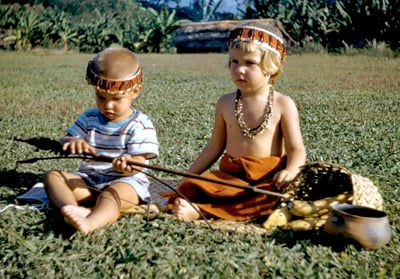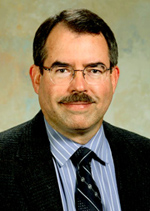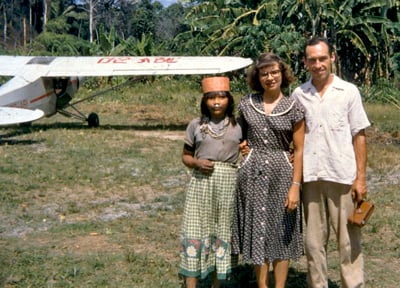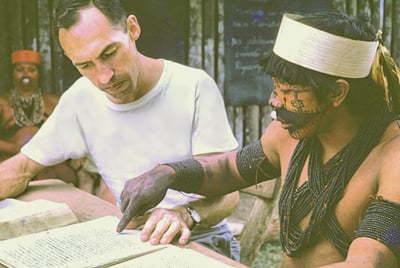 |
| David Russell and his older sister, Lois, play with an Amahuaca bow and arrow near their jungle home in 1963. |
(Dec. 21, 2012 - by Harold Goerzen) With a remote corner of the Amazon rainforest as his playground, David Russell might surprise even himself at the role technology has played in his life and career as a missionary.
Growing up as the son of missionaries translating the Bible into the Amahuaca language, little Russell found the flora and fauna of the Peruvian jungle fascinating.
"I had my own bow and arrow since I was probably 3 years old. I liked to hunt lizards and go fishing every day," he said, adding that dangers often lurked. "You never knew what was in the river when we went swimming-whether huge anacondas or little piranhas. One time a piranha nearly bit off my left pinkie!" The Russells also faced disease, bandits and isolation in an area accessible only by light plane, on foot or by canoe.
 |
| David Russell |
Now overseeing efforts at sharing the gospel via numerous technologies, Russell, 52, recalls his parents' use of just a few devices to share the gospel with the Amahuaca of southeastern Peru. He remembers Robert and Delores Russell's painstaking analysis of biblical passages late into the night beneath a single light bulb powered by a small gasoline generator. Then Bob would record the translated passage on a wind-up, reel-to-reel tape recorder with a built-in speaker.
"He would translate a portion of Scripture; then record it over and over again and play it back to the Indians in the hopes that the reading would be clearly understood," Russell said. "That recorder was part of the first wave of technology that I have experienced in my lifetime in terms of tools for sharing the good news with others. It was just a simple tool, but it had a big impact."
With just 15 families in the village, the content of the message was highly customized and contextualized for this very specific group of listeners, according to Russell. He also saw technology's advantages each school year when he and his siblings would commute between the village and Wycliffe Bible Translators' boarding school. |
| Robert and Delores Russell with language helper Cacuuyama in 1955. The Piper Super Cub in the background served to transport the Russells in the early days once the airstrip was built. |
At the school in Yarinacocha on the Ucayali River, Russell's wonder for technology thoroughly took root. "My interest in technology was really sparked when I was 8 years old and my parents were preparing for a visit by my paternal grandparents," he recalled. "I went with my dad to the JAARS (formerly Jungle Aviation and Radio Service) hangar where we called by ham radio to an operator in Ohio who patched the call through to my grandfather. I knew he was thousands of miles away, yet the signal was clear. I've had a fascination with long-distance communication ever since."
The elder Russell's response was to help his son build a primitive crystal radio-a coil of copper wire on a toilet paper roll with a crystal diode and a strip of aluminum that slid up and down the coil of wire to select stations. "There were almost no radio stations in the area, but I fell in love with radio. That became a passion of mine, and it did a lot to drive my career." In Russell's life, long-distance listening ranks as the second wave of technology with an almost unlimited audience and programming of general interest to listeners worldwide.
"High-powered shortwave radio reached a huge, diverse audience," he explained, specifying that HCJB, the Voice of the Andes, brought friendly voices and messages of encouragement into the Russell home. When the family moved to Lima for medical reasons, the unrationed use of electricity and wider access to broadcast equipment fed Russell's interest in technology.
 |
| David's father, Robert Russell, works with an Amahuaca man to translate the Scriptures. |
He went on to earn a degree in electrical engineering from LeTourneau University in Texas and eventually landed what for him was a dream job at Hughes Space and Communications. In 1984 he married Giselle Gotelli, a nurse from Southern California.
Giselle learned at an Urbana youth missions conference of HCJB Global's need for both nurses and engineers in Ecuador. Their exploratory trip to Ecuador served to confirm for both of them that God was calling them to serve with the missionary organization. The Russells left their rewarding jobs in the U.S. and began work in Ecuador in 1991. They transferred to the Technology Center in Elkhart, Ind., in 2000. Russell was later appointed as the center's executive director.
The Technology Center has worked to put more than 400 partner radio stations on the air in some 100 countries. "This third wave of technology is more of a hybrid," observed Russell. "Using local FM or regional shortwave, the stations operate on a much smaller scale than international shortwave. They air programs that are more contextual, and relevant to the local environment and social needs."
 |
| Ray Rising adjusts a 1,000-watt regional shortwave transmitter produced at the HCJB Global Technology Center. The unit was recently installed in Chazuta, Peru, making Christian broadcasts available to 19 language groups. |
Earlier this year, for example, engineers from the Technology Center helped missionary Ray Rising, Radio Logos and local believers at Chazuta, Peru, put a regional shortwave station on the air.
At this Christmastime, several jungle communities will hear the story of Christ's birth in their mother tongue for the first time by radio. There are 19 indigenous language groups within reach of this new station in northeastern Peru.
Tribespeople from these groups are operating the station and serving as the program producers. Currently, broadcasts are being aired in Achuar, Bora, Junicui, Ticuna, Pastaza Quechua, San Martín Quechua and Spanish.
Of a fourth wave of technology, Russell surmised that "as an organization, we are just beginning to harness it," but described some aspects of it. "It's heavily Internet-based and uses a lot of video content. It's also tailored for consumption over smart mobile devices."
 |
| Amahuaca man in traditional dress. |
"The concept here is using emergent technology where people can choose content that is relevant to them," Russell explained. "You can reach an unlimited number of people, but the content can be contextualized for specific listeners or viewers."
Another aspect of the Technology Center is the Jack and June Nikkel Media Center, opened in 2011, which serves the staff and media interns in Elkhart. It is a laboratory for learning how to make the most of the new communication tools, and for sharing that knowledge with others who are also eager to reach the unreached with the gospel.
"We haven't abandoned the second and third waves of technology," Russell said, citing examples of the Technology Center's work in shortwave radio and helping plant FM stations worldwide. "But we have to come up to speed on the fourth wave. I trust that we will be guided by the Lord and not just by human fascination with technology."
Source: HCJB Global
